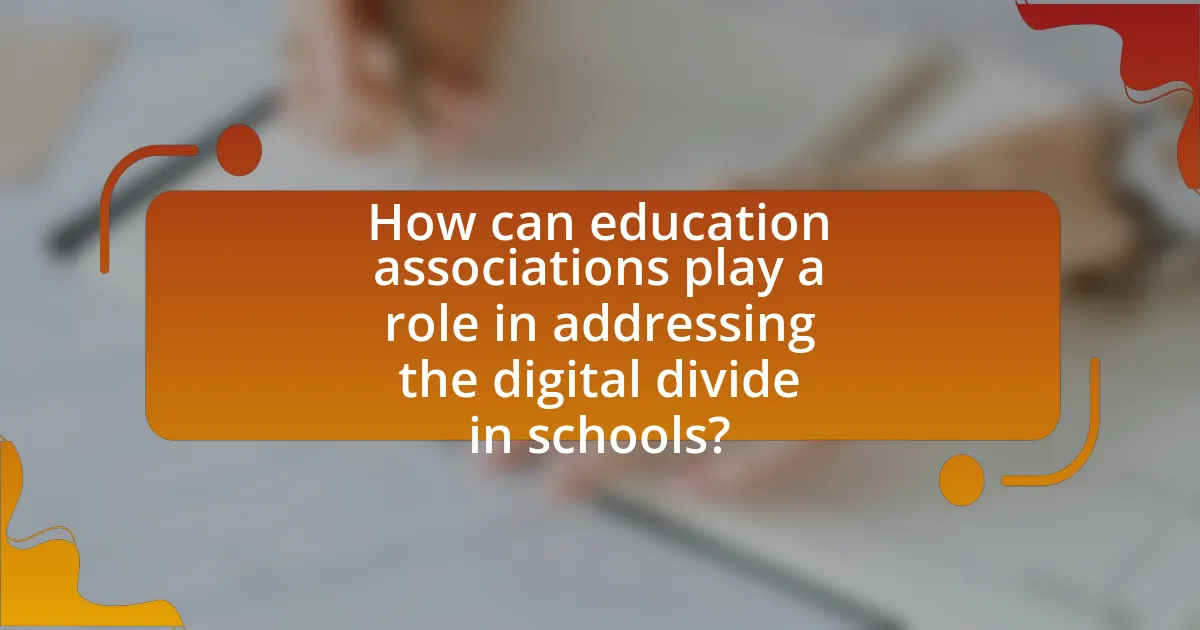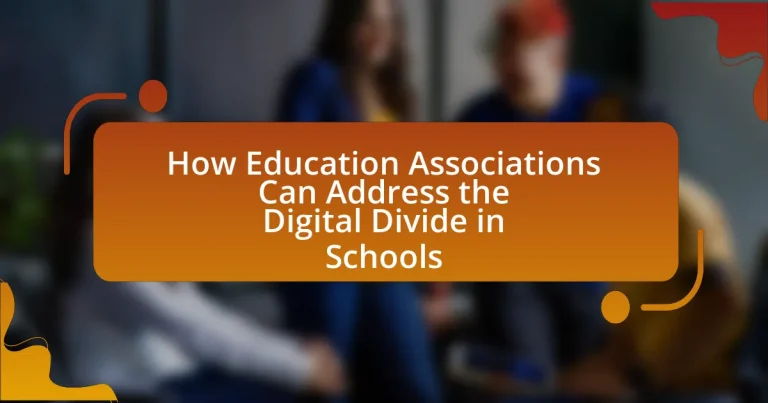Education associations play a vital role in addressing the digital divide in schools by advocating for equitable access to technology and resources. This article explores the significance of the digital divide in education, its impact on student learning outcomes, and the key factors contributing to this issue. It outlines various initiatives that education associations can implement, such as partnerships with technology companies, professional development for educators, and advocacy for policy changes to secure funding for underserved schools. Additionally, the article discusses the challenges faced by these associations, the importance of community resources, and strategies for sustaining efforts to promote digital equity in education.

How can education associations play a role in addressing the digital divide in schools?
Education associations can play a crucial role in addressing the digital divide in schools by advocating for equitable access to technology and resources. These associations can influence policy decisions at local, state, and national levels, ensuring that funding is allocated to underserved schools for technology infrastructure. For instance, the National Education Association has actively supported initiatives that promote digital equity, highlighting the need for broadband access and devices for all students. Additionally, education associations can provide professional development for educators on integrating technology into the classroom, thereby enhancing teaching and learning experiences. By collaborating with technology companies and community organizations, education associations can facilitate partnerships that bring resources and training to schools in need, effectively bridging the digital divide.
What is the digital divide and why is it significant in education?
The digital divide refers to the gap between individuals who have access to digital technology and the internet and those who do not. This divide is significant in education because it affects students’ ability to engage with online learning resources, participate in digital classrooms, and develop essential technological skills. According to a report by the National Center for Education Statistics, approximately 14% of U.S. households with school-age children lacked internet access in 2020, highlighting the disparities in educational opportunities. This lack of access can lead to lower academic performance and hinder future career prospects for affected students.
How does the digital divide impact student learning outcomes?
The digital divide significantly impacts student learning outcomes by creating disparities in access to technology and online resources. Students without reliable internet access or devices are less likely to complete assignments, participate in online learning, and develop digital literacy skills, which are essential for academic success. Research from the Pew Research Center indicates that 35% of lower-income families with school-age children lack high-speed internet, leading to lower academic performance and engagement compared to their peers with adequate access. This gap in access not only affects immediate learning but also has long-term implications for college readiness and career opportunities.
What are the key factors contributing to the digital divide in schools?
The key factors contributing to the digital divide in schools include socioeconomic status, access to technology, and internet connectivity. Socioeconomic status significantly influences students’ ability to acquire devices and access high-speed internet; for instance, a report from the Pew Research Center indicates that 35% of lower-income households with school-age children lack a reliable internet connection. Access to technology is often uneven, with schools in affluent areas having more resources to provide devices and infrastructure compared to those in underfunded districts. Additionally, disparities in digital literacy among students and educators further exacerbate the divide, as those with less experience may struggle to utilize available technology effectively.
What initiatives can education associations implement to bridge the digital divide?
Education associations can implement initiatives such as providing access to technology resources, offering training programs for educators, and advocating for policy changes to bridge the digital divide. For instance, associations can partner with technology companies to supply devices and internet access to underserved schools, which addresses the lack of necessary tools for digital learning. Additionally, training programs can equip teachers with the skills to effectively integrate technology into their curricula, enhancing student engagement and learning outcomes. Advocacy efforts can focus on securing funding for digital infrastructure improvements, as evidenced by the Federal Communications Commission’s E-Rate program, which has provided over $3 billion annually to support internet access in schools. These initiatives collectively work to ensure equitable access to digital education resources.
How can education associations promote access to technology for underserved schools?
Education associations can promote access to technology for underserved schools by facilitating partnerships with technology companies to provide resources and training. These associations can leverage their networks to secure donations of hardware, software, and internet access, which are critical for bridging the digital divide. For instance, initiatives like the “Tech for Schools” program have successfully connected over 1,000 schools with technology providers, resulting in increased access to digital tools for students in low-income areas. Additionally, education associations can advocate for policy changes that allocate funding specifically for technology in underserved schools, ensuring that these institutions receive the necessary financial support to enhance their technological capabilities.
What partnerships can education associations form to enhance digital equity?
Education associations can form partnerships with technology companies, community organizations, and government agencies to enhance digital equity. Collaborating with technology companies allows education associations to secure resources such as devices and software, which can be distributed to underserved students. Partnering with community organizations helps to identify local needs and facilitate access to digital literacy programs, ensuring that families are equipped to support their children’s learning. Additionally, working with government agencies can lead to funding opportunities and policy advocacy aimed at closing the digital divide, as evidenced by initiatives like the Federal Communications Commission’s E-Rate program, which provides discounts for internet access in schools and libraries.
What challenges do education associations face in addressing the digital divide?
Education associations face significant challenges in addressing the digital divide, primarily due to resource limitations, varying levels of technological infrastructure, and disparities in access to training. Resource limitations hinder the ability to provide adequate funding and support for technology initiatives, while the inconsistent technological infrastructure across different regions creates unequal opportunities for students. Additionally, disparities in access to training for educators and students exacerbate the divide, as many lack the necessary skills to effectively utilize digital tools. According to a report by the National Center for Education Statistics, approximately 14% of students in the U.S. do not have access to the internet at home, highlighting the urgency of these challenges.
How can funding limitations affect the initiatives of education associations?
Funding limitations significantly hinder the initiatives of education associations by restricting their ability to implement programs and resources aimed at addressing educational disparities. When financial resources are scarce, education associations may struggle to develop and maintain technology infrastructure, training for educators, and access to digital learning tools, which are essential for bridging the digital divide in schools. For instance, a report from the National Education Association indicates that inadequate funding can lead to a lack of professional development opportunities for teachers, ultimately affecting student engagement and learning outcomes. Consequently, without sufficient funding, education associations cannot effectively support initiatives that promote equitable access to education and technology for all students.
What resistance might education associations encounter from stakeholders?
Education associations may encounter resistance from stakeholders primarily due to differing priorities and perspectives on resource allocation. Stakeholders, including parents, school administrators, and policymakers, might prioritize immediate educational needs over long-term digital initiatives, leading to pushback against proposed changes. For instance, a survey by the National Center for Education Statistics indicated that 60% of school leaders expressed concerns about funding for technology integration, highlighting a significant barrier to implementing digital solutions. Additionally, some stakeholders may resist changes due to a lack of understanding of the benefits of addressing the digital divide, which can hinder collaboration and support for education associations’ initiatives.
How can education associations measure the effectiveness of their efforts?
Education associations can measure the effectiveness of their efforts by utilizing data analytics to assess student performance and engagement metrics. By collecting and analyzing data on student outcomes, such as test scores and graduation rates, associations can determine the impact of their initiatives on closing the digital divide. For instance, a study by the Pew Research Center found that targeted interventions in technology access led to a 15% increase in student engagement in underserved communities. This evidence supports the effectiveness of education associations’ strategies in addressing disparities in digital access.
What metrics should be used to evaluate progress in closing the digital divide?
To evaluate progress in closing the digital divide, key metrics include internet access rates, digital literacy levels, and technology adoption in educational settings. Internet access rates measure the percentage of households with reliable internet connections, which is crucial for online learning. Digital literacy levels assess the ability of individuals to effectively use technology, indicating how well students can engage with digital resources. Technology adoption in schools evaluates the integration of devices and digital tools in classrooms, reflecting the availability of resources for students. According to the Federal Communications Commission, as of 2021, approximately 14 million Americans still lacked access to high-speed internet, highlighting the ongoing need for targeted interventions.
How can feedback from schools inform future initiatives by education associations?
Feedback from schools can inform future initiatives by education associations by providing direct insights into the challenges and needs faced by educators and students. This feedback allows education associations to tailor their programs and resources to address specific gaps, such as access to technology and digital literacy skills. For instance, a survey conducted by the National Education Association revealed that 70% of teachers identified a lack of access to digital tools as a significant barrier to effective teaching. By analyzing such data, education associations can develop targeted initiatives that enhance digital access and training, ultimately bridging the digital divide in schools.
What best practices can education associations adopt to effectively address the digital divide?
Education associations can effectively address the digital divide by implementing targeted initiatives that enhance access to technology and digital literacy. These initiatives include providing funding for technology resources in underserved schools, facilitating partnerships with tech companies to supply devices and internet access, and offering professional development for educators to improve digital teaching skills. For instance, a report by the Pew Research Center indicates that 15% of U.S. households with school-age children do not have high-speed internet access, highlighting the urgent need for such interventions. By focusing on these best practices, education associations can significantly reduce disparities in digital access and ensure equitable educational opportunities for all students.
How can education associations leverage community resources to support their initiatives?
Education associations can leverage community resources by forming partnerships with local businesses, nonprofits, and government agencies to enhance their initiatives. These collaborations can provide access to funding, technology, and expertise that are essential for addressing the digital divide in schools. For instance, a study by the Pew Research Center indicates that community partnerships can significantly improve resource allocation, with 70% of schools reporting enhanced technology access through local collaborations. By utilizing these community resources, education associations can effectively implement programs that ensure equitable access to digital tools for all students.
What role does advocacy play in the efforts of education associations to reduce the digital divide?
Advocacy plays a crucial role in the efforts of education associations to reduce the digital divide by influencing policy decisions and mobilizing resources. Education associations actively engage with policymakers to promote equitable access to technology and internet connectivity for underserved communities. For instance, the National Education Association (NEA) has advocated for increased funding for broadband infrastructure, which is essential for closing the digital gap. Research indicates that approximately 17% of students in the U.S. lack reliable internet access, highlighting the need for targeted advocacy efforts. By raising awareness and pushing for legislative changes, education associations help ensure that all students have the necessary tools for digital learning, thereby addressing systemic inequalities in education.
What are the next steps for education associations in tackling the digital divide?
Education associations should prioritize collaboration with technology companies to provide affordable internet access and devices to underserved communities. By forming partnerships, these associations can leverage resources and expertise to implement programs that directly address the digital divide. For instance, the Federal Communications Commission reported that approximately 14 million students lack adequate internet access for remote learning, highlighting the urgency for education associations to act. Additionally, education associations can advocate for policy changes that support funding for digital infrastructure in schools, ensuring equitable access to technology for all students.
How can education associations engage with policymakers to promote digital equity?
Education associations can engage with policymakers to promote digital equity by actively participating in advocacy efforts that highlight the importance of equitable access to technology in education. These associations can organize forums and workshops that bring together educators, policymakers, and community stakeholders to discuss the challenges and solutions related to digital access. For instance, the National Education Association has successfully lobbied for increased funding for technology in underserved schools, demonstrating the effectiveness of targeted advocacy. By presenting data on the impact of digital inequity on student outcomes, such as the 2021 report from the Pew Research Center indicating that 15% of U.S. households with school-age children lacked high-speed internet, education associations can strengthen their case for policy changes that support digital equity initiatives.
What strategies can education associations use to sustain their efforts over time?
Education associations can sustain their efforts over time by implementing continuous professional development programs, fostering partnerships with technology companies, and advocating for policy changes that support equitable access to digital resources. Continuous professional development ensures that educators remain informed about the latest technologies and teaching strategies, which is essential for addressing the digital divide. Partnerships with technology companies can provide schools with necessary resources and training, enhancing the effectiveness of educational initiatives. Advocacy for policy changes can lead to increased funding and support for digital equity initiatives, ensuring that all students have access to the tools they need for success. These strategies are supported by research indicating that sustained efforts in professional development and collaboration significantly improve educational outcomes in underserved communities.


